
Click the name of a planet to learn more about its visibility in July 2020: Jupiter, Saturn, Mars, Venus, Mercury
Try Stellarium for a precise view of the planets from your location.
Want precise planet rise and set times? Click here for recommended almanacs
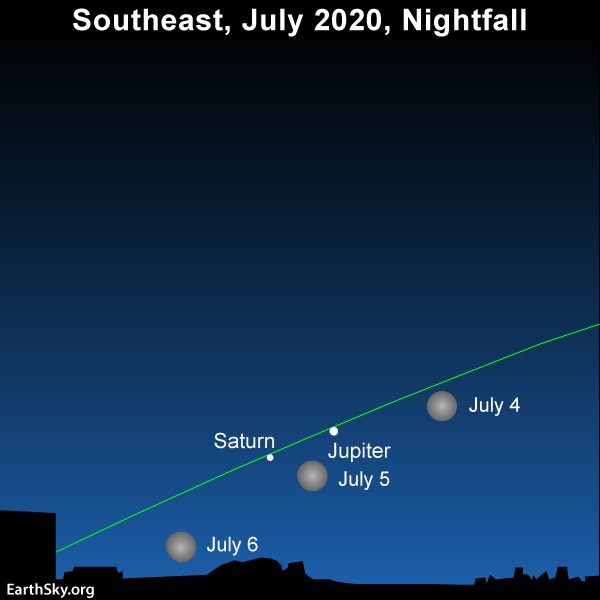
Watch for the moon to appear in the vicinity of Jupiter and Saturn for several days, centered on or near June 5, 2020. Read more.
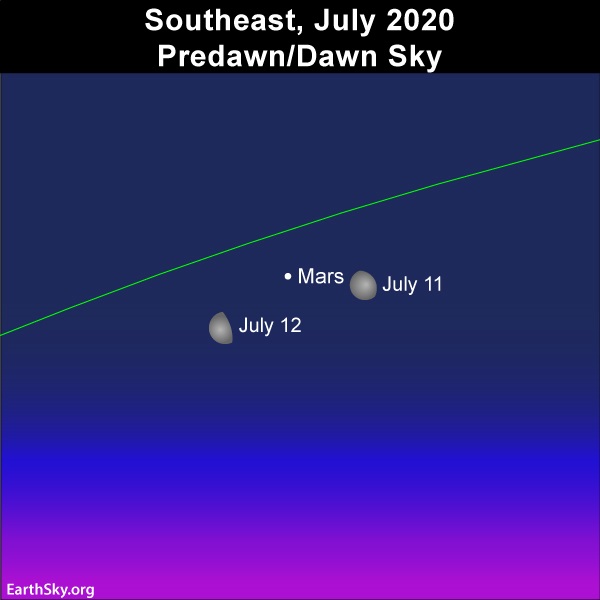
Get up early on July 11 and 12, 2020, to see the waning moon with the red planet Mars. Read more.
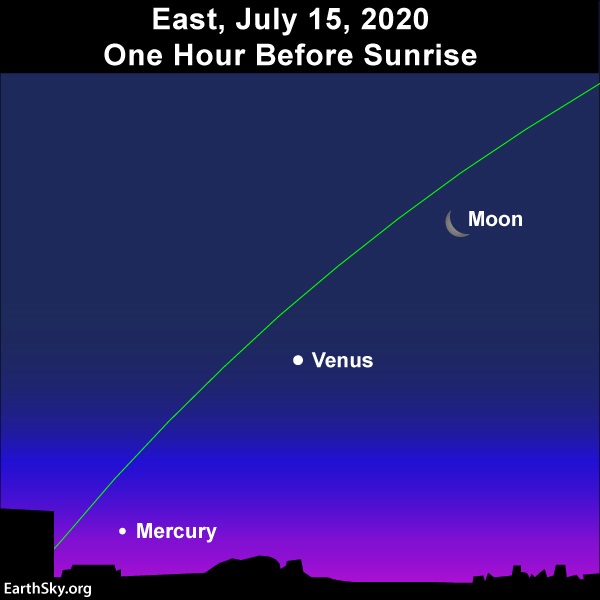
Starting in mid-July 2020, use the waning crescent moon and Venus to locate Mercury near the horizon as the morning darkness begins to give way to dawn. Read more.
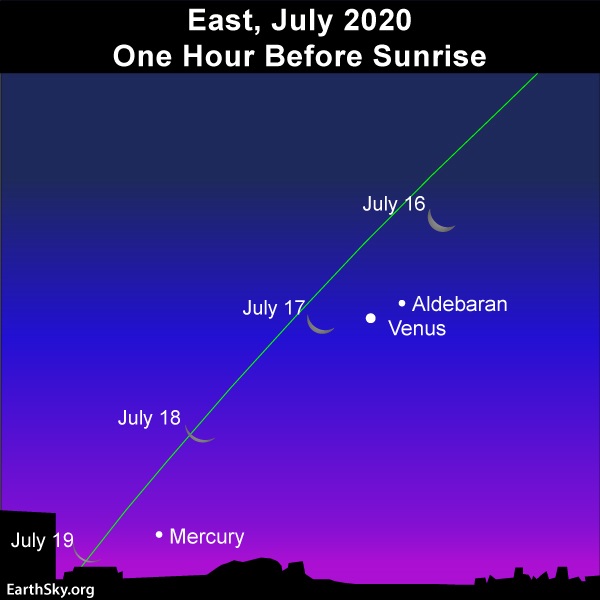
The waning crescent moon passes to the north of dazzling Venus on or near July 17. Read more.
Jupiter and Saturn are near one another on the sky’s dome, with Saturn following Jupiter westward across the sky from early evening until dawn. Around the world, Jupiter and nearby Saturn rise during nightfall in early July, around sunset in mid-July, and before sundown by the month’s end.
It’s a banner month for these gas giant worlds, as Jupiter and Saturn both come to opposition this month. At and around opposition, Earth swings closest to Jupiter and Saturn for the year, and Jupiter and Saturn, in turn, shine at their brightest best and are out all night long.
Read more: Jupiter at opposition on July 13-14
Read more: We go between Saturn and the sun July 20
Look first for brilliant Jupiter and you’ll find Saturn a rather short hop to the east of the king planet. Although Saturn is easily as bright as a 1st-magnitude star, the ringed planet pales next the the king planet Jupiter, which outshines Saturn by some 15 times. After all, Jupiter ranks as the fourth brightest celestial object, after the sun, moon, and the planet Venus, respectively.
Watch for the moon in the vicinity of Jupiter and Saturn for several days, centered on or near July 5.
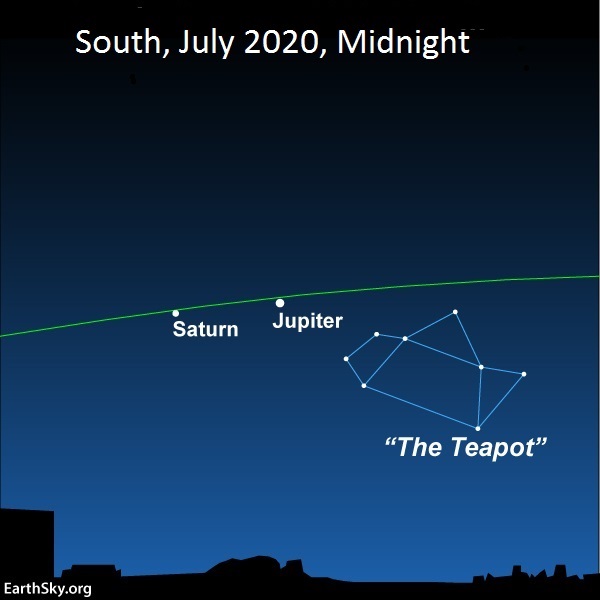
In July 2020, Jupiter and Saturn climb up highest for the night around midnight. Given an unobstructed southeast horizon, you should have little trouble catching the planets Jupiter and Saturn low in the southeast sky at nightfall or early evening. Use Jupiter and Saturn to find the “Teapot” asterism in the constellation Sagittarius the Archer. Read more.
Mars is the first of the three bright morning planets to rise in July 2020: Mars comes up at late night, roughly around midnight. Then, a few to several hours later, Venus rises into the predawn sky; and by the second half of July 2020, Mercury will appear below Venus at morning dawn.
Sometime this month, Mars will rise before midnight, to sit low in the east at late evening. By August, look for Mars to be up by mid-to-late evening.
At mid-northern latitudes, Mars rises around the midnight hour in early July, and roughly 10 p.m. (11 p.m. daylight-saving time) by the month’s end. By midnight, we mean midway between sunset and sunrise.
At temperate latitudes in the Southern Hemisphere, Mars comes up at or near the midnight hour in early July, and about an hour earlier by the month’s end.
Let the waning moon help guide your eye to Mars on the mornings of July 11 and 12.
In July 2020 … you’ll find Mars respectably bright – easily as brilliant as a 1st-magnitude star – in the predawn/dawn sky. Earth will be rushing along in its smaller, faster orbit, gaining on Mars, the fourth planet outward from the sun. Throughout the next three months, watch for Mars to brighten dramatically as Earth closes in on Mars. The red planet will appear brightest in our sky and fiery red – around the time of its opposition – when Earth passes between Mars and the sun on October 13, 2020. At that wondrous time, Mars will actually supplant Jupiter as the sky’s fourth-brightest celestial body, after the sun, moon, and the planet Venus, respectively.

View at EarthSky Community Photos. | From Paul Armstrong, who took this photo of Mars, Saturn and Jupiter on the morning of April 15, 2020, from Exmoor, U.K. Jupiter is at the upper right, Mars at center left, with Saturn between them. In May 2020, Jupiter and Saturn were closer together, whereas Mars was farther away from Jupiter and Saturn. Thanks, Paul!
Venus – the brightest planet – rushed between the Earth and sun (inferior conjunction) on June 3, 2020. At that point, it transitioned out of the evening sky and into the morning sky. We first saw Venus reappear in the east at dawn around mid-June. Throughout July, this blazing world will climb progressively higher into the eastern predawn sky.
At mid-northern latitudes, Venus rises about 2 hours before the sun in early July, increasing to about 3 hours by the month’s end.
At and near the equator, Venus rises about 2 1/3 hours before the sun in early July, increasing to over 3 hours near the month’s end.
At temperate latitudes in the Southern Hemisphere, Venus rises about 2 2/3 hours before the sun in early July, increasing to over 3 hours by the month’s end.
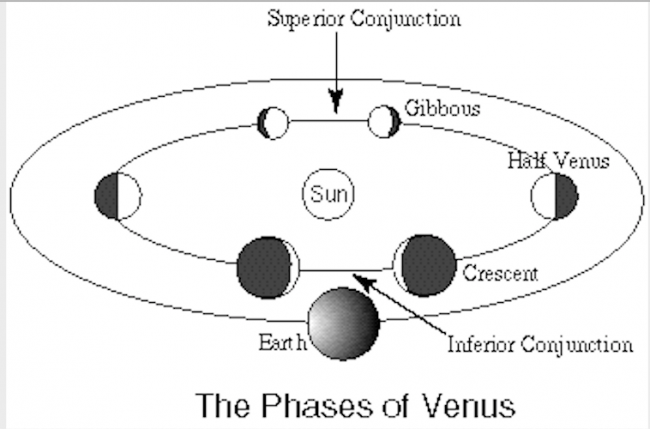
Inferior conjunction – when Venus sweeps between the sun and Earth – happened on June 3, 2020. Just before inferior conjunction, we saw Venus as a thin waning crescent in the evening sky; and just after inferior conjunction, we saw Venus as a thin waxing crescent in the morning sky. In July 2020, Venus will start the month about 19 percent illuminated and end the month about 42 percent illuminated. Image via UCLA.
Throughout July, Venus in its faster orbit around the sun will be going farther and farther away from Earth. As viewed through the telescope, Venus’ waxing crescent phase will widen, yet its overall disk size will shrink. Venus’ disk is 19 percent illuminated in early July, and about 42 percent illuminated by the month’s end; Venus’ angular diameter, on the other hand, will shrink to 2/3rd the size by the month’s end.
Look for Venus to beam at its brightest in the morning sky on or around July 10, 2020, when Venus displays its greatest illuminated extent on the sky’s dome. Venus always beams at its brightest best when its disk is about one-quarter illuminated by sunshine. In fact, if you’re up before dawn, note that Venus at its brightest closely couples up with Aldebaran, the brightest star in the constellation Taurus the Bull.
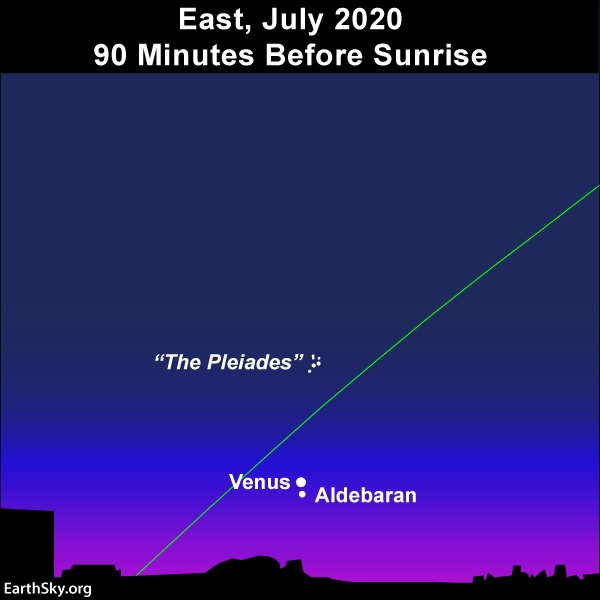
If you’re up before dawn July 10, 2020, look for Aldebaran, the brightest star in the constellation Taurus the Bull, quite close to Venus on the sky’s dome. Read more.
Watch for the waning crescent moon in the vicinity of Venus for several days, centered on or near July 17.
Mercury transitions out of the evening sky and into the morning sky on July 1, and then reaches its greatest elongation in the morning sky on July 22, 2020. We expect Mercury to become visible in the eastern dawn sky around mid-month. Have binoculars handy, however, for Mercury has to compete with the glow of morning twilight. Given an unobstructed horizon in the direction of sunrise, you have a reasonably good chance of catching Mercury in the second half of July, as this world brightens throughout the month.
For several mornings, starting on or around July 16, let the waning crescent moon and the brilliant planet Venus guide you to Mercury’s place near the horizon.
Mercury reaches its greatest elongation on July 22, 2020, at which juncture Mercury will be 20 degrees west of the sun. After that date, Mercury will slowly fall sunward day by day.
Here are Mercury’s approximate rising times for 40 degrees north latitude, the equator (0 degrees latitude) and 35 degrees south latitude (given an unobstructed eastern horizon):
40 degrees north latitude:
July 15: Mercury rises 66 minutes (1 1/10 hours) before the sun
July 22: Mercury rises 90 minutes (1 1/2 hours) before the sun
August 1: Mercury rises 80 minutes (1 1/3 hours) before the sunEquator (0 degrees latitude)
July 15: Mercury rises 75 minutes (1 1/4 hours) before sunrise
July 22: Mercury rises 84 minutes (1 2/5 hours) before sunrise
August 1: Mercury rises 66 minutes (1 1/10 hours) before sunrise35 degrees south latitude
July 15: Mercury rises 80 minutes (1 1/3 hours) before sunrise
July 22: Mercury rises 80 minutes (1 1/3 hours) before sunrise
August 1: Mercury rises 45 minutes (3/4 hour) before sunriseFor more specific information, check out recommended sky almanacs
What do we mean by bright planet? By bright planet, we mean any solar system planet that is easily visible without an optical aid and that has been watched by our ancestors since time immemorial. In their outward order from the sun, the five bright planets are Mercury, Venus, Mars, Jupiter and Saturn. These planets actually do appear bright in our sky. They are typically as bright as – or brighter than – the brightest stars. Plus, these relatively nearby worlds tend to shine with a steadier light than the distant, twinkling stars. You can spot them, and come to know them as faithful friends, if you try.
Bottom line: July 2020 presents all 5 bright solar system planets. Catch Jupiter and Saturn at early evening and throughout the night, Mars between midnight and dawn, Venus in the predawn/dawn sky, and Mercury below Venus at dawn in the second half of July.
Don’t miss anything. Subscribe to EarthSky News by email
Visit EarthSky’s Best Places to Stargaze, and recommend a place we can all enjoy.
Help EarthSky keep going! Donate now.
Post your planet photos at EarthSky Community Photos
from EarthSky https://ift.tt/1YD00CF

Click the name of a planet to learn more about its visibility in July 2020: Jupiter, Saturn, Mars, Venus, Mercury
Try Stellarium for a precise view of the planets from your location.
Want precise planet rise and set times? Click here for recommended almanacs

Watch for the moon to appear in the vicinity of Jupiter and Saturn for several days, centered on or near June 5, 2020. Read more.

Get up early on July 11 and 12, 2020, to see the waning moon with the red planet Mars. Read more.

Starting in mid-July 2020, use the waning crescent moon and Venus to locate Mercury near the horizon as the morning darkness begins to give way to dawn. Read more.

The waning crescent moon passes to the north of dazzling Venus on or near July 17. Read more.
Jupiter and Saturn are near one another on the sky’s dome, with Saturn following Jupiter westward across the sky from early evening until dawn. Around the world, Jupiter and nearby Saturn rise during nightfall in early July, around sunset in mid-July, and before sundown by the month’s end.
It’s a banner month for these gas giant worlds, as Jupiter and Saturn both come to opposition this month. At and around opposition, Earth swings closest to Jupiter and Saturn for the year, and Jupiter and Saturn, in turn, shine at their brightest best and are out all night long.
Read more: Jupiter at opposition on July 13-14
Read more: We go between Saturn and the sun July 20
Look first for brilliant Jupiter and you’ll find Saturn a rather short hop to the east of the king planet. Although Saturn is easily as bright as a 1st-magnitude star, the ringed planet pales next the the king planet Jupiter, which outshines Saturn by some 15 times. After all, Jupiter ranks as the fourth brightest celestial object, after the sun, moon, and the planet Venus, respectively.
Watch for the moon in the vicinity of Jupiter and Saturn for several days, centered on or near July 5.

In July 2020, Jupiter and Saturn climb up highest for the night around midnight. Given an unobstructed southeast horizon, you should have little trouble catching the planets Jupiter and Saturn low in the southeast sky at nightfall or early evening. Use Jupiter and Saturn to find the “Teapot” asterism in the constellation Sagittarius the Archer. Read more.
Mars is the first of the three bright morning planets to rise in July 2020: Mars comes up at late night, roughly around midnight. Then, a few to several hours later, Venus rises into the predawn sky; and by the second half of July 2020, Mercury will appear below Venus at morning dawn.
Sometime this month, Mars will rise before midnight, to sit low in the east at late evening. By August, look for Mars to be up by mid-to-late evening.
At mid-northern latitudes, Mars rises around the midnight hour in early July, and roughly 10 p.m. (11 p.m. daylight-saving time) by the month’s end. By midnight, we mean midway between sunset and sunrise.
At temperate latitudes in the Southern Hemisphere, Mars comes up at or near the midnight hour in early July, and about an hour earlier by the month’s end.
Let the waning moon help guide your eye to Mars on the mornings of July 11 and 12.
In July 2020 … you’ll find Mars respectably bright – easily as brilliant as a 1st-magnitude star – in the predawn/dawn sky. Earth will be rushing along in its smaller, faster orbit, gaining on Mars, the fourth planet outward from the sun. Throughout the next three months, watch for Mars to brighten dramatically as Earth closes in on Mars. The red planet will appear brightest in our sky and fiery red – around the time of its opposition – when Earth passes between Mars and the sun on October 13, 2020. At that wondrous time, Mars will actually supplant Jupiter as the sky’s fourth-brightest celestial body, after the sun, moon, and the planet Venus, respectively.

View at EarthSky Community Photos. | From Paul Armstrong, who took this photo of Mars, Saturn and Jupiter on the morning of April 15, 2020, from Exmoor, U.K. Jupiter is at the upper right, Mars at center left, with Saturn between them. In May 2020, Jupiter and Saturn were closer together, whereas Mars was farther away from Jupiter and Saturn. Thanks, Paul!
Venus – the brightest planet – rushed between the Earth and sun (inferior conjunction) on June 3, 2020. At that point, it transitioned out of the evening sky and into the morning sky. We first saw Venus reappear in the east at dawn around mid-June. Throughout July, this blazing world will climb progressively higher into the eastern predawn sky.
At mid-northern latitudes, Venus rises about 2 hours before the sun in early July, increasing to about 3 hours by the month’s end.
At and near the equator, Venus rises about 2 1/3 hours before the sun in early July, increasing to over 3 hours near the month’s end.
At temperate latitudes in the Southern Hemisphere, Venus rises about 2 2/3 hours before the sun in early July, increasing to over 3 hours by the month’s end.

Inferior conjunction – when Venus sweeps between the sun and Earth – happened on June 3, 2020. Just before inferior conjunction, we saw Venus as a thin waning crescent in the evening sky; and just after inferior conjunction, we saw Venus as a thin waxing crescent in the morning sky. In July 2020, Venus will start the month about 19 percent illuminated and end the month about 42 percent illuminated. Image via UCLA.
Throughout July, Venus in its faster orbit around the sun will be going farther and farther away from Earth. As viewed through the telescope, Venus’ waxing crescent phase will widen, yet its overall disk size will shrink. Venus’ disk is 19 percent illuminated in early July, and about 42 percent illuminated by the month’s end; Venus’ angular diameter, on the other hand, will shrink to 2/3rd the size by the month’s end.
Look for Venus to beam at its brightest in the morning sky on or around July 10, 2020, when Venus displays its greatest illuminated extent on the sky’s dome. Venus always beams at its brightest best when its disk is about one-quarter illuminated by sunshine. In fact, if you’re up before dawn, note that Venus at its brightest closely couples up with Aldebaran, the brightest star in the constellation Taurus the Bull.

If you’re up before dawn July 10, 2020, look for Aldebaran, the brightest star in the constellation Taurus the Bull, quite close to Venus on the sky’s dome. Read more.
Watch for the waning crescent moon in the vicinity of Venus for several days, centered on or near July 17.
Mercury transitions out of the evening sky and into the morning sky on July 1, and then reaches its greatest elongation in the morning sky on July 22, 2020. We expect Mercury to become visible in the eastern dawn sky around mid-month. Have binoculars handy, however, for Mercury has to compete with the glow of morning twilight. Given an unobstructed horizon in the direction of sunrise, you have a reasonably good chance of catching Mercury in the second half of July, as this world brightens throughout the month.
For several mornings, starting on or around July 16, let the waning crescent moon and the brilliant planet Venus guide you to Mercury’s place near the horizon.
Mercury reaches its greatest elongation on July 22, 2020, at which juncture Mercury will be 20 degrees west of the sun. After that date, Mercury will slowly fall sunward day by day.
Here are Mercury’s approximate rising times for 40 degrees north latitude, the equator (0 degrees latitude) and 35 degrees south latitude (given an unobstructed eastern horizon):
40 degrees north latitude:
July 15: Mercury rises 66 minutes (1 1/10 hours) before the sun
July 22: Mercury rises 90 minutes (1 1/2 hours) before the sun
August 1: Mercury rises 80 minutes (1 1/3 hours) before the sunEquator (0 degrees latitude)
July 15: Mercury rises 75 minutes (1 1/4 hours) before sunrise
July 22: Mercury rises 84 minutes (1 2/5 hours) before sunrise
August 1: Mercury rises 66 minutes (1 1/10 hours) before sunrise35 degrees south latitude
July 15: Mercury rises 80 minutes (1 1/3 hours) before sunrise
July 22: Mercury rises 80 minutes (1 1/3 hours) before sunrise
August 1: Mercury rises 45 minutes (3/4 hour) before sunriseFor more specific information, check out recommended sky almanacs
What do we mean by bright planet? By bright planet, we mean any solar system planet that is easily visible without an optical aid and that has been watched by our ancestors since time immemorial. In their outward order from the sun, the five bright planets are Mercury, Venus, Mars, Jupiter and Saturn. These planets actually do appear bright in our sky. They are typically as bright as – or brighter than – the brightest stars. Plus, these relatively nearby worlds tend to shine with a steadier light than the distant, twinkling stars. You can spot them, and come to know them as faithful friends, if you try.
Bottom line: July 2020 presents all 5 bright solar system planets. Catch Jupiter and Saturn at early evening and throughout the night, Mars between midnight and dawn, Venus in the predawn/dawn sky, and Mercury below Venus at dawn in the second half of July.
Don’t miss anything. Subscribe to EarthSky News by email
Visit EarthSky’s Best Places to Stargaze, and recommend a place we can all enjoy.
Help EarthSky keep going! Donate now.
Post your planet photos at EarthSky Community Photos
from EarthSky https://ift.tt/1YD00CF


Aucun commentaire:
Enregistrer un commentaire